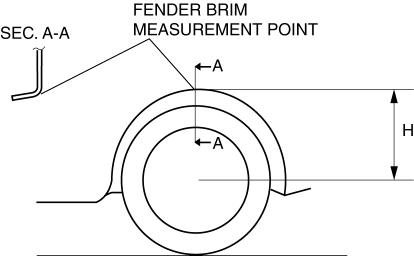Mazda CX-5 Service & Repair Manual: Wheel Alignment Pre Inspection
1. Park the vehicle on level ground, in an unloaded condition*, with the wheels straight forward.
*: Unloaded condition.....Fuel tank is full. Engine coolant and engine oil are at specified level. Spare tire, jack and tools are in designated position.
2. Inspect the tire pressure.
-
Adjust to the recommended pressure if necessary..
3. Inspect the wheel bearing play.
-
Correct if necessary..
4. Inspect the wheel runout.
-
Correct if necessary..
5. Rock the vehicle, and verify that there is no looseness in the steering wheel joint and suspension ball joint.
6. Rock the vehicle, and verify that the shock absorber operates properly.
7. Measure height H from the center of the wheel to the fender brim.

8. Verify that the difference between the left and right dimension H is within the specification.
-
If it exceeds the specification, repeat the Step 2—7.
-
Standard specification
-
10 mm {0.39 in} or less
 Wheels, Tires
Wheels, Tires
...
 Wheel Apron Component Installation [Panel Replacement]
Wheel Apron Component Installation [Panel Replacement]
Symbol Mark
Installation Procedure
1. When installing new parts, measure and adjust the body as necessary to conform
with standard dimensions.
2. Drill holes for the plug welding before inst ...
Other materials:
Suspension
49 T034 1A0
Coil spring compressor set
49 T028 3A0
Ball joint puller set
49 G033 102
Handle
49 U034 204
Dust boot installer
49 FT01 389
Pr ...
Fuel Injection Control System
Outline
Performs optimum fuel injection according to engine operation conditions.
The PCM determines the engine operation conditions based on the signals from
each input device and drives the fuel injectors at the optimal fuel injection
time (fuel injection amount) and the fuel ...
Air Bag System [Two Step Deployment Control System]
Outline
The air bag system is a device that supplements the passenger restraint function
of the seat belts. The air bag system will not have the designed effect if the
seat belts are not worn properly.
The air bag system is composed of the following parts:
...
